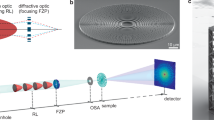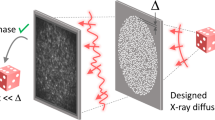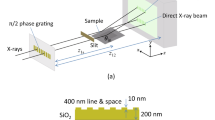Abstract
Lensless X-ray imaging techniques such as coherent diffraction imaging1,2,3,4,5,6,7,8 and ptychography9,10,11, and Fourier transform holography12,13,14,15,16,17 can provide time-resolved, diffraction-limited images. Nearly all examples of these techniques have focused on transmission geometry, restricting the samples and reciprocal spaces that can be investigated. We report a lensless X-ray technique developed for imaging in Bragg and small-angle scattering geometries, which may also find application in transmission geometries. We demonstrate this by imaging a nanofabricated pseudorandom binary structure in small-angle reflection geometry. The technique can be used with extended objects, places no restriction on sample size, and requires no additional sample masking. The realization of X-ray lensless imaging in reflection geometry opens up the possibility of single-shot imaging of surfaces in thin films, buried interfaces in magnetic multilayers, organic photovoltaic and field-effect transistor devices, or Bragg planes in a single crystal.
This is a preview of subscription content, access via your institution
Access options
Subscribe to this journal
Receive 12 print issues and online access
$209.00 per year
only $17.42 per issue
Buy this article
- Purchase on Springer Link
- Instant access to full article PDF
Prices may be subject to local taxes which are calculated during checkout




Similar content being viewed by others
References
Nugent, K. A. Coherent methods in the X-ray sciences. Adv. Phys. 59, 1–99 (2010).
Miao, J., Charalambous, P., Kirz, J. & Sayre, D. Extending the methodology of X-ray crystallography to allow imaging of micrometre-sized non-crystalline specimens. Nature 400, 342–344 (1999).
Chapman, H. N. et al. Femtosecond time-delay X-ray holography. Nature 448, 676–679 (2007).
Chapman, H. N. et al. High-resolution ab initio three-dimensional X-ray diffraction microscopy. J. Opt. Soc. Am. A 23, 1179–1200 (2006).
Nugent, K. A., Peele, A. G., Chapman, H. N. & Mancuso, A. P. Unique phase recovery for nonperiodic objects. Phys. Rev. Lett. 91, 203902 (2003).
Shapiro, D. et al. Biological imaging by soft X-ray diffraction microscopy. Proc. Nat. Acad. Sci. USA 102, 15343–15346 (2005).
Nelson, J. et al. High-resolution X-ray diffraction microscopy of specifically labeled yeast cells. Proc. Nat. Acad. Sci. USA 107, 7235–7239 (2010).
Pfeifer, M. A., Williams, G. J., Vartanyants, I. A., Harder, R. & Robinson, I. K. Three-dimensional mapping of a deformation field inside a nanocrystal. Nature 442, 63–66 (2006).
Rodenburg, J. M. et al. Hard-X-ray lensless imaging of extended objects. Phys. Rev. Lett. 98, 034801 (2007).
Thibault, P. et al. High-resolution scanning X-ray diffraction microscopy. Science 321, 379–382 (2008).
Dierolf, M. et al. Ptychographic coherent diffractive imaging of weakly scattering specimens. New J. Phys. 12, 035017 (2010).
McNulty, I. et al. High-resolution imaging by Fourier transform X-ray holography. Science 256, 1009–1012 (1992).
Marchesini, S. et al. Massively parallel X-ray holography. Nature Photon. 2, 560–563 (2008).
Eisebitt, S. et al. Lensless imaging of magnetic nanostructures by X-ray spectro-holography. Nature 432, 885–888 (2004).
Chamard, V. et al. Three-dimensional X-ray Fourier transform holography: the Bragg case. Phys. Rev. Lett. 104, 165501 (2010).
Stadler, L.-M. et al. Hard X ray holographic diffraction imaging. Phys. Rev. Lett. 100, 245503 (2008).
Stickler, D. et al. Soft X-ray holographic microscopy. Appl. Phys. Lett. 96, 042501 (2010).
Zhang, F., Pedrini, G. & Osten, W. Phase retrieval of arbitrary complex-valued fields through aperture-plane modulation. Phys. Rev. A 75, 043805 (2007).
Johnson, I. et al. Coherent diffractive imaging using phase front modifications. Phys. Rev. Lett. 100, 155503 (2008).
Quiney, H. M., Peele, A. G., Cai, Z., Paterson, D. & Nugent, K. A. Diffractive imaging of highly focused X-ray fields. Nat. Phys. 2, 101–104 (2006).
Fienup, J. R. Reconstruction of a complex-valued object from the modulus of its Fourier transform using a support constraint. J. Opt. Soc. Am. A 4, 118–123 (1987).
Fienup, J. R. Phase retrieval algorithms: a comparison. Appl. Opt. 21, 2758–2769 (1982).
Marchesini, S. et al. X-ray image reconstruction from a diffraction pattern alone. Phys. Rev. B 68, 140101 (2003).
Higgins, G. & Wolfe, R. The relation of definition to sharpness and resolving power in a photographic system. J. Opt. Soc. Am. 45, 121–129 (1955).
Acknowledgements
The authors thank S. Marchesini of the Lawrence Berkeley National Laboratory (LBNL) for helpful discussions. This work at LBNL was supported by the Director, Office of Science, Office of Basic Energy Sciences, of the US Department of Energy (contract no. DE-AC02-05CH11231). Work in the group of S.D.K. at U. Oregon was supported by the National Science Foundation (grant no. DMR-0506241).
Author information
Authors and Affiliations
Contributions
S.R. conceived the experiment. S.R., K.A.S. and D.P. designed the experiment. W.C. and E.H.A. fabricated the test pattern. S.C. fabricated the exit screen. D.P., K.A.S., R.S. and S.R. preformed the experiments. D.P., K.A.S. and S.R. analysed the data. S.R., K.A.S., D.P., J.J.T. and S.D.K. authored the paper. All authors discussed the results and contributed to the final manuscript.
Corresponding author
Ethics declarations
Competing interests
The authors declare no competing financial interests.
Supplementary information
Supplementary information
Supplementary information (PDF 219 kb)
Supplementary Movie
Supplementary Mpvie (AVI 1166 kb)
Rights and permissions
About this article
Cite this article
Roy, S., Parks, D., Seu, K. et al. Lensless X-ray imaging in reflection geometry. Nature Photon 5, 243–245 (2011). https://doi.org/10.1038/nphoton.2011.11
Received:
Accepted:
Published:
Issue Date:
DOI: https://doi.org/10.1038/nphoton.2011.11



